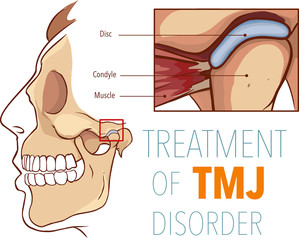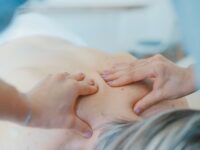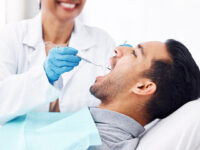Symptoms Of TMJ Disorders
Symptoms include pain or tenderness of the jaw or face, clicking sounds, or restricted movement of the mouth. It is important to exhaust all conservative reversible remedies before moving toward more aggressive treatments such as bridgework or surgery.
The condition can also cause symptoms that mimic other conditions such as chronic headaches, sinus or ear problems, or neck pain. Research suggests that 85% of patients with TMJ have comorbid health issues. Contact Saunders Therapy Centers, Inc professionals for an appointment.
 Symptoms
Symptoms
Symptoms of TMJ vary from person to person, but they often include pain in the chewing muscles and/or jaw joint (the most common symptom), limited movement of the jaw or neck, and clicking, popping, or grating noises when the mouth is opened or closed. These symptoms may also be accompanied by headaches, ringing in the ears, or dizziness. Symptoms of TMJ can be caused by many things, such as stress, teeth grinding or clenching (“bruxism”), arthritis, dental malocclusion, or physical trauma to the jaw or head.
Unlike most health conditions, TMJ is difficult to diagnose. Because of this, it is important to let your doctor know if you have these symptoms. Your doctor will ask questions, do an exam, and might order imaging tests like X-rays, CT scans, or MRIs to help make a diagnosis.
TMJ can cause serious problems if left untreated, so it’s important to see your doctor right away if you think you have TMJ. Treatment options for TMJ range from simple at-home remedies to more involved therapies, like injections and surgery. Most doctors recommend starting with conservative treatments before moving on to more aggressive methods.
During your exam, your provider will assess the position of your jaw and jaw muscles; palpate (examine) your temporomandibular joints for swelling or muscle spasm; look for limited movement of your jaw or neck; listen to your jaw click, pop, or grate when you open and close your mouth; check if your teeth fit together well; and examine your ear canal for any signs of inflammation. Your doctor will also ask about your health history, especially if you’ve had any trauma to the jaw or neck, or if you have other health problems, like rheumatoid arthritis, osteoarthritis, or fibromyalgia.
TMJ can affect people of all ages and ethnic backgrounds, but it is more common in women during childbearing years and in those with a history of stress or trauma to the jaw or neck. In addition, several other health conditions are commonly found in conjunction with TMJ, including chronic sinusitis, rheumatoid arthritis, fibromyalgia, depression, anxiety, and bipolar disorder.
Diagnosis
TMJ disorders affect the chewing muscles and joints that connect your lower jawbone to your skull. They’re found on each side of your head, just in front of your ears. Your temporomandibular joints allow you to open and close your mouth and also help you chew. Your jaw may click, pop, or lock when you have a TMJ disorder. The conditions can range from mild to severe. The disorder’s symptoms include jaw pain, ringing in the ears (tinnitus), and difficulty opening or closing your mouth.
To diagnose TMJ, your doctor will ask about the symptoms you’re having. Then he or she will do a physical examination of your jaw and neck. This includes a head and neck muscle exam, an evaluation of the quality and magnitude of your jaw movements, and a listening examination for temporomandibular joint sounds during these movements. Your dentist will also take a dental history and an X-ray of your temporomandibular joints.
The most common treatments for TMJ are over-the-counter or prescription medications, a soft diet, and avoiding habits that put stress on the jaw area (like chewing gum, clenching or grinding your teeth during the day, and opening your mouth wide when you’re yawning). You may receive a bite plate or splint to help balance the forces on your temporomandibular joints. You may also receive a short-term treatment with a steroid injection into your temporomandibular joint to ease inflammation and reduce pain and other symptoms.
Other possible diagnostic procedures include arthroscopy and arthrocentesis. Arthroscopy involves a small needle and syringe to drain fluid from the joint. This helps your surgeon to see what is causing the swelling and working out the best treatment for you. Arthrocentesis is done under sedation and uses a needle and syringe to remove bone fragments, scar tissue, and other debris from the joint area that can cause swelling and pain. In most cases, doctors will start with home treatments and only move on to more extensive treatment options if these are not effective. A recurrence of TMJ symptoms after treatment is a good indication that you need to make some changes in your lifestyle or habits.
Treatment
TMJ symptoms can be very difficult to diagnose and are often brushed off by patients, who may think their pain is “normal”. Patients with chronic jaw pain or headaches should seek medical attention from a healthcare provider or dentist trained in facial pain management. They may need to be referred to other specialists, such as an ear, nose, and throat (ENT) doctor or neurosurgeon, depending on the severity of their symptoms.
Most cases of TMJ are mild or temporary, and symptoms may improve on their own within weeks or months. Practicing self-care, such as eating soft foods, applying ice packs or moist heat, and avoiding habits that irritate the temporomandibular joint or muscles of the face (such as chewing gum, clenching or grinding teeth, or opening the mouth wide when yawning), can help alleviate symptoms.
In more severe cases, a physician or dentist can prescribe oral splints to keep the mouth shut and reduce clenching. Medications, such as low doses of tricyclic antidepressants, which are typically used for depression, are also sometimes prescribed for pain relief and to control bruxism. Physical therapy, such as exercises to stretch and strengthen the jaw muscles, can be helpful. In some people, acupuncture can also reduce pain.
Surgical treatments to treat TMJ are rare but may be recommended for those with severe, debilitating symptoms or those who have not responded to other treatment options. During arthroscopy, a physician can view the inside of the temporomandibular joint and remove scar tissue, or adhesions, that may be restricting movement. This procedure is effective in improving pain and function.
TMJ is a complex disorder and, despite the many treatments available, it can be very difficult to find what will work best for each patient. It is important to try and exhaust all reversible remedies before resorting to more permanent treatment, such as surgery. A non-profit organization that offers support for TMJ sufferers and helps patients understand their rights when they see healthcare providers, including how to protect themselves from being overcharged or treated unnecessarily.
Prevention
TMJ disorders are caused by injuries or infections to the jaw’s temporomandibular joint and its supporting muscles, which allow the jaw to open and close. TMJ symptoms can be uncomfortable, but they usually improve with time or treatment. If you are experiencing jaw pain or difficulty opening your mouth, it is important to contact a dentist to discuss treatment options. Dentists can help treat TMJ symptoms and prevent them from worsening over time.
Many factors contribute to TMJ, but most cases of TMJ are preventable. For example, it is important to chew foods in small pieces and to avoid chewing gum for long periods. It is also important to wear a mouth guard or reduce habits like teeth clenching, chewing on hard objects, and biting your nails. Using a warm or cold compress on the area of the face affected by TMJ can help relieve pain. Taking over-the-counter nonsteroidal anti-inflammatory medications (NSAIDs) such as ibuprofen can also relieve pain and help ease inflammation.
In addition, it is a good idea to exercise regularly, get enough sleep, and manage stress levels. These activities can decrease the risk of TMJ by decreasing tension and inflammation in the jaw muscles and the surrounding areas. Getting regular chiropractic adjustments can also help reduce TMJ pain by improving the function of the joints and muscles.
Several conditions can be comorbid with TMJ, such as neck and back problems, depression, anxiety, migraines, fibromyalgia, interstitial cystitis, rheumatoid arthritis, and Sjogren’s syndrome. These comorbid conditions can affect multiple systems in the body, such as the circulatory, digestive, endocrine, exocrine, skeletal, and nervous systems.
For children, preventing TMJ can be as simple as avoiding eating hard foods helping them to stop clenching or grinding their teeth, and opening their mouths wide when they yawn. It’s also a good idea to make sure kids are getting plenty of exercise and sleep and to teach them to relax. If your child is prone to clenching or grinding their teeth, ask your pediatric dentist for a bite splint to prevent them from putting pressure on the TM joint and muscles.




